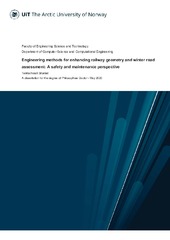| dc.contributor.advisor | Boubekki, Ahcene | |
| dc.contributor.advisor | Ahonen, Heidi | |
| dc.contributor.author | Kjøtrød, Tor | |
| dc.date.accessioned | 2023-08-21T06:42:39Z | |
| dc.date.available | 2023-08-21T06:42:39Z | |
| dc.date.issued | 2023-06-01 | en |
| dc.description.abstract | The thesis focuses on the unsupervised segmentation of submarine recordings collected by the Norwegian Polar Institute (NPI) using hydrophones. These recordings consists of various mammal species, along with other phenomena like vessel engines, seismic activity, and moving sea ice. With sparse labeling of the data, a supervised learning approach is not feasible, necessitating the application of unsupervised learning techniques to uncover underlying patterns and structures.
The thesis begins by providing essential background theory, including the Fourier transform, spectrograms, and an introduction to clustering algorithms. It then covers the forward pass, parameter update and backpropagation of neural networks. Key components of neural networks and machine learning, such as different layers, activation functions, and loss functions, are also explained.
Furthermore, well-known deep learning architectures, namely convolutional neural networks, autoencoders, and recurrent neural networks, are introduced. The Temporal Neighborhood coding method, which encodes underlying states of multivariate, non-stationary time-series, and the clustering module that integrates a Gaussian mixture model into a loss function for deep autoencoders, are introduced.
The proposed data and methods are presented, followed by experimental results evaluating the performance of the two architectures for segmenting both a simulated dataset and the spectrogram of the submarine recordings. The thesis concludes with a discussion of the results and future directions, highlighting the promising outcomes of the segmentation methods while emphasizing the need for additional data information to further enhance model performance and for further evaluation of the methods performance. | en_US |
| dc.identifier.uri | https://hdl.handle.net/10037/30100 | |
| dc.language.iso | eng | en_US |
| dc.publisher | UiT Norges arktiske universitet | no |
| dc.publisher | UiT The Arctic University of Norway | en |
| dc.rights.holder | Copyright 2023 The Author(s) | |
| dc.rights.uri | https://creativecommons.org/licenses/by-nc-sa/4.0 | en_US |
| dc.rights | Attribution-NonCommercial-ShareAlike 4.0 International (CC BY-NC-SA 4.0) | en_US |
| dc.subject.courseID | FYS-3941 | |
| dc.subject | VDP::Mathematics and natural science: 400::Mathematics: 410::Applied mathematics: 413 | en_US |
| dc.subject | Deep learning | en_US |
| dc.subject | VDP::Mathematics and natural science: 400::Information and communication science: 420::Simulation, visualization, signal processing, image processing: 429 | en_US |
| dc.subject | Signal Processing | en_US |
| dc.subject | VDP::Mathematics and natural science: 400::Mathematics: 410::Applied mathematics: 413 | en_US |
| dc.subject | Machine Learning | en_US |
| dc.subject | VDP::Mathematics and natural science: 400::Mathematics: 410::Applied mathematics: 413 | en_US |
| dc.subject | Unsupervised Learning | en_US |
| dc.title | Unsupervised segmentation of submarine recordings | en_US |
| dc.type | Mastergradsoppgave | no |
| dc.type | Master thesis | en |


 English
English norsk
norsk



